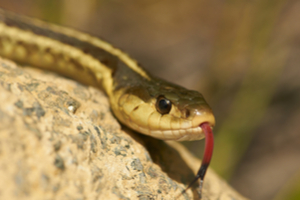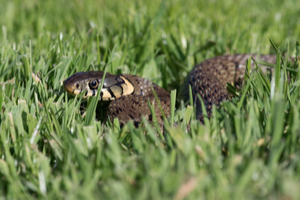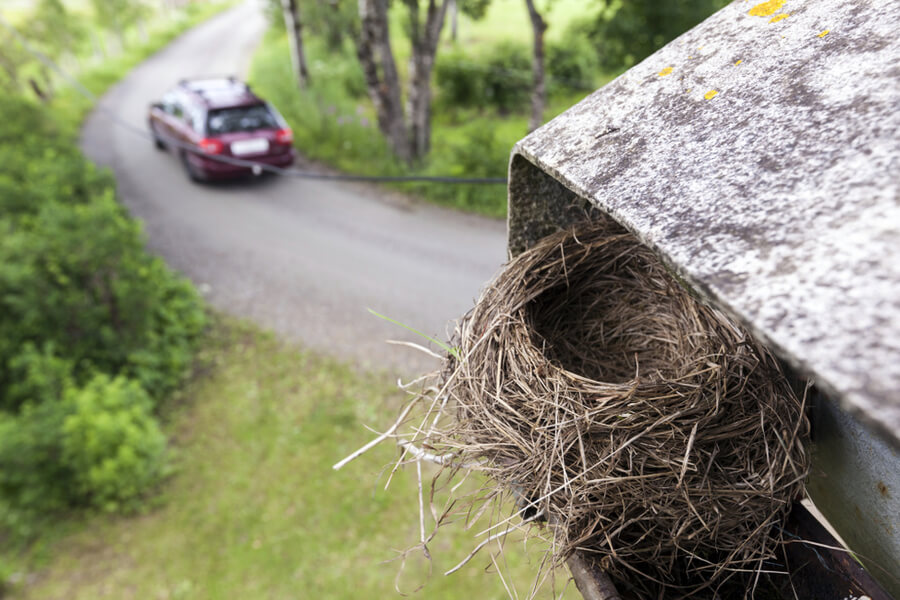Why are snakes active this time of year?
 Contrary to popular belief, snakes don’t like the hot temperatures of summer any more than most of us do. In fact, on particularly hot days, snakes have to scramble to find shade or they’ll overheat and die. You might run into snakes as they move back and forth from sunny places to shade.
If snakes seem particularly active to you now, it’s probably because they’re looking for mates. Snakes mate in early summer so their eggs will hatch during late summer and early fall. During mating season, snakes seek each other out more than usual, and compete for mates.
Contrary to popular belief, snakes don’t like the hot temperatures of summer any more than most of us do. In fact, on particularly hot days, snakes have to scramble to find shade or they’ll overheat and die. You might run into snakes as they move back and forth from sunny places to shade.
If snakes seem particularly active to you now, it’s probably because they’re looking for mates. Snakes mate in early summer so their eggs will hatch during late summer and early fall. During mating season, snakes seek each other out more than usual, and compete for mates.
Where am I likely to find snakes?
Where snakes are on any given day depends on the temperature, weather, and time of day. On hot summer days, snakes seek out shade and shelter to stay cool. They’re most common in tall grass or beneath cover like rocks, shady trees, decks, or porches. On cooler, overcast days, snakes may come out into the open to sunbathe for longer periods of time. You might find them on heat-reflective surfaces like glass or concrete. Snakes are at their most active when it’s cool out. They move around most in the early morning and around dusk. Snakes hunt in tall grass, weeds, and other sources of vegetation. Around your home, they’ll seek out shady or dark places where they can rest and cool down. Snakes also tend to look for humid areas where they can stay hydrated. Smaller snakes may enter your home through cracks and crevices, similar to other pests.Why are snakes near my home?
 Snakes need shelter, moisture, and food to survive. If they’re slinking around your home, it’s because you’re inadvertently providing them with a source of these things. Snakes require cover and shelter to protect them from excessive heat and predators like hawks. They love overgrown vegetation and grass, and often burrow through loose topsoil.
Snakes need moisture to stay cool and hydrated during hot summer days. They’re attracted to puddles, wet grass, sunken spots, and other stagnant water. Water like this also tends to attract rodents and insects, which snakes can eat. If you see a lot of snakes around your home, it’s possible you have other pests to worry about, too.
Snakes need shelter, moisture, and food to survive. If they’re slinking around your home, it’s because you’re inadvertently providing them with a source of these things. Snakes require cover and shelter to protect them from excessive heat and predators like hawks. They love overgrown vegetation and grass, and often burrow through loose topsoil.
Snakes need moisture to stay cool and hydrated during hot summer days. They’re attracted to puddles, wet grass, sunken spots, and other stagnant water. Water like this also tends to attract rodents and insects, which snakes can eat. If you see a lot of snakes around your home, it’s possible you have other pests to worry about, too.
Are the snakes near my home dangerous?
Possibly, but it’s highly unlikely. Only 3% of the snakes found in the US are venomous. Despite the fact that snake encounters are very common, snake bites are very rare. Fewer than one in 37,500 people are bitten by venomous snakes in the US every year. Only one in 50 million people die of snake bites every year. It’s nine times more likely you’ll be killed by lightning than by a snake bite. That being said, venomous snakes do live in the Midwest. However unlikely it may be, snakes will lash out if they’re surprised, threatened, or cornered. As a general rule, venomous snakes have diamond-shaped heads. Treat all snakes with caution. Do not approach them or make sudden movements near them. If you’re bitten by a snake, wash the wound and seek medical attention immediately. Dangerous snake bites are very rare, but it’s always better to be safe than sorry.How can I keep these snakes away?
 Snakes come to your home for the cover, moisture, darkness, and food it provides. Driving them back out means taking these things away from them. First, find as many places to deprive snakes of cover as possible. Mow the grass short, trim bushes frequently, and remove lawn debris. Snakes hate feeling exposed and avoid open, highly-visible areas.
Next, look for and address sources of excess moisture. Make sure your garden hose and spout aren’t dripping. Patch up any plumbing leaks. Make sure you aren’t over-watering your grass or garden. Finally, patch up the cracks and crevices that snakes may use to access your home. Start in the basement and work your way up.
No one should have to be afraid to walk around their own yard. We hope this info helps, but we’d understand if you’re still not exactly excited to run into a snake. The reptiles are rarely dangerous, but they’re never pleasant.
If you’d rather not have to deal with any snakes this summer, give Varment Guard a call any time. We have the tools and knowhow to find, trap, and remove snakes quickly and effectively.
Snakes come to your home for the cover, moisture, darkness, and food it provides. Driving them back out means taking these things away from them. First, find as many places to deprive snakes of cover as possible. Mow the grass short, trim bushes frequently, and remove lawn debris. Snakes hate feeling exposed and avoid open, highly-visible areas.
Next, look for and address sources of excess moisture. Make sure your garden hose and spout aren’t dripping. Patch up any plumbing leaks. Make sure you aren’t over-watering your grass or garden. Finally, patch up the cracks and crevices that snakes may use to access your home. Start in the basement and work your way up.
No one should have to be afraid to walk around their own yard. We hope this info helps, but we’d understand if you’re still not exactly excited to run into a snake. The reptiles are rarely dangerous, but they’re never pleasant.
If you’d rather not have to deal with any snakes this summer, give Varment Guard a call any time. We have the tools and knowhow to find, trap, and remove snakes quickly and effectively.







